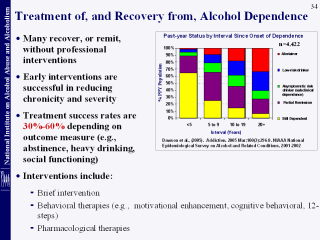Search for most updated materials ↑
| front |1 |2 |3 |4 |5 |6 |7 |8 |9 |10 |11 |12 |13 |14 |15 |16 |17 |18 |19 |20 |21 |22 |23 |24 |25 |26 |27 |28 |29 |30 |31 |32 |33 |34 |35 |36 |37 |38 |39 |40 |41 |42 |review |
 |
In the U.S., only a small proportion
of individuals with Alcohol Use Disorders seek or receive treatment
for their alcohol problems. Epidemiological data
suggest that in any given year only about 12% seek help for their
drinking (broadly defined to include a spectrum of help ranging from
Alcoholics Anonymous to specialized alcoholism treatment).
Over the course of their lifetime, only 24% receive any kind
of treatment. When people do
seek treatment, they typically do so between the ages of 40 and 44
years. Thus, the existing treatment system tends to accommodate
middle-aged individuals, despite the peak prevalence for AUDs among
younger individuals (Grant et al., 2004, Drug and Alc Dep.,
74:223-234). Many younger
persons “mature out” of AUDs as they age, and many drinkers recover
or remit from AUD without any
professional intervention.
Some investigators have referred to this phenomenon as
“natural recovery.” Of
persons with “past” Alcohol
Dependence in the 2001-2002 survey year, 25% were still dependent,
27.3% were in partial remission, 11.8% were asymptomatic risk
drinkers, 17.7% were low-risk drinkers, and 18.2% became complete
abstainers (Dawson et al.,2005, Addiction, 100(3):281-292).
To further illustrate the natural
history of Alcohol Dependence, the inset displays past-year
drinking status of the NESARC survey population by interval since
Alcohol Dependence onset. In
2001-2002, 64.9% of those who had experienced dependence onset
within the past 5 years remained dependent compared with only 6.9%
of those who had experienced an onset of dependence 20 or more years
earlier. Similarly, only 6.0%
of persons with recent onset were abstinent or low-risk drinkers
compared with 61.0% of those whose dependence originated 20 or more
years earlier.
|